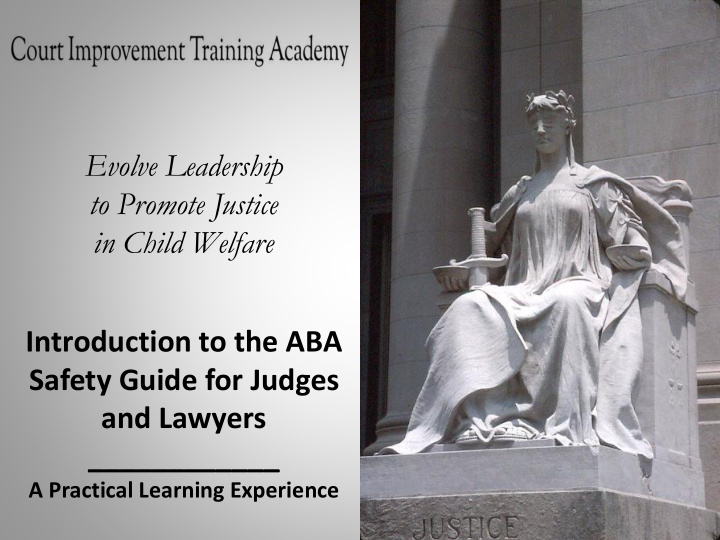



Evolve Leadership to Promote Justice in Child Welfare Introduction to the ABA Safety Guide for Judges and Lawyers ____________ A Practical Learning Experience
Speed networking 1. What do you hope is accomplished during this training program? 2. What will you contribute to the use of this framework in your court?
9 Why’s: Finding Clarity and Purpose… Why do you work in the child welfare court system?
Child Safety Framework _______________ A Language and Structure for Decision- Making In Dependency Court
Greater Breadth of Discussion at initial hearing … • Increased rate of appearance of parties at subsequent hearings • Higher likelihood of placement with parents or kin at immediately subsequent hearings (following six months) • Increase in services ordered for both parents • Earlier permanency and closure of case, and increase in reunification as case outcome • Enhancing the level of discussion at the preliminary hearing can be initiated by any of the professionals. Alicia Summers, Sophia I. Gatowski, Melissa Gueller (2017). The relationship between breadth of discussion and case outcomes.
Safety Assessment • Gathering Information • Foundation for case analysis Safety Plans • Based on Safety Assessment • In-Home • Out-of-Home Conditions for Return • Based on Safety Assessment • Foundation for Case Plan Case Plan • Based on Safety Assessment • Eliminates Threats or Enhances Protective Capacity Progress, Reunification, Dismissal • Judged against Safety Assessment Reunification ≠ Dismissal •
The Judge Expects Information 6 Core Questions 1. What is the nature and extent of the maltreatment? 2. What circumstances accompany the maltreatment? 3. How does the child function day-to-day? 4. How does the parent discipline the child? 5. What are overall parenting practices? 6. How does the parent manage his/her own life?
Threats Are there sufficient protective capacities to protect child(ren) from threats to which they are vulnerable? Protective Vulnerabilities Capacities
Threats • Specific and Observable • Out of Control • Immediate or Liable to Happen Soon • Severe Consequences
Vulnerabilities • Child Specific • Vulnerable or Not, Not Judged in Degrees • If Threat Exists, Presume Vulnerability
Protective Capacity • Cognitive • Behavioral • Emotional
Threat or No Threat? • Specific and Observable • Out of Control • Immediate or Liable to Happen Soon • Severe Consequences
When sufficient information collected: Decide if threats of danger exist No threats exist: if Threats exist: protective action decide if child is was taken terminate vulnerable to it; child is SAFE threats Child is not vulnerable to threats: Child is SAFE Child is vulnerable to threats: Decide if sufficient protective capacities to manage threats exist Insufficient Sufficient protective protective capacities exist to capacities exist to manage threats: manage threats: Child is UNSAFE Child is SAFE
The Judge Expects Information 6 Core Questions 1. What is the nature and extent of the maltreatment? 2. What circumstances accompany the maltreatment? 3. How does the child function day-to-day? 4. How does the parent discipline the child? 5. What are overall parenting practices? 6. How does the parent manage his/her own life?
Safety Planning • Does not require change in parents behavior or attitude • Controls threats – immediately --------------------------------------------- • Sufficient • Feasible • Sustainable --------------------------------------------- • Assessing Reasonable Efforts • Actions or Services to Control or Manage Threats
Safety Planning Out-of Home Plan • Assessing Reasonable Efforts • Conditions for Return - Clearly • Value Congruence • Behavior/Circumstance- Based Language • Kind and Amount of Parent- Child contact.
Case Planning • Use Safety Framework to design case plan. • Looking toward the Court and Dept exiting Family. • Usually requires changing in parental behavior
HOPE THEORY Safety Plan And Case plan goals Will Power (Agency) Safety Plan actions EXPECTATION “ Progess ” on case FOR GOAL plan ATTAINMENT Think: Resilience Way Power (Pathways) …agency without pathways is a wish!
Visitation Plans • Assess - Learn - Practice - Demonstrate ------------------------------------------------------------- • Quick to Start • Include Siblings • Alternative Contact • Written Plan – Court Order • Right of Family – Not Carrot-and- Stick • Explain Supervision • How will it progress?
Evaluating Success Why Can’t Children Go Home Today? • Reduction of Threats? Emergence of New Threats? • Status of Protective Capacity? • Current Information for Answers? • Why Disputes? Challenge Parties to Resolve. • If no progress, why? • Demand Information/Perspective of Parents
Reunification • Have conditions changed enough to support an In-Home Safety Plan? Sustainable: • Can the plan be put into place? and can it work until it is no longer needed? • Observe visits • Can unsupervised visits be happening now? • Are any of the visits structured to provide information about the child-parent relationship • Parent Attitudes re: Threats and Protective Factors • Info from Treatment Providers
Reunification • Are We Preparing the Care Provider to Support Reunification? • Is the Recommendation of Social Worker Independent and Supported . • Reunification is a Plan, not an event.
Terminating Jurisdiction • Threats Eliminated • Protective Capacity Enhanced to Control Threats • Combination of Both
Evolve Leadership to Promote Justice in Child Welfare Introduction to the ABA Safety Guide for Judges and Lawyers ____________ A Practical Learning Experience
Recommend
More recommend